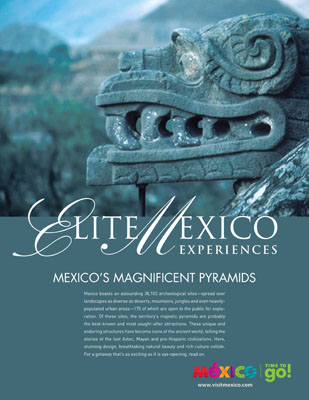| Tracing back to pre-Hispanic civilizations and beyond, the
advertisement doubles as an informational pamphlet for on-looking
tourists. Readers are visually introduced to the images of Templo Mayor
in Mexico City, the ruins at Teotihuacan, Veracruz, Monte Alban, Oaxaca,
El Tajin, Veracruz, the pyramids at Chichen Itza, Uxmal, and, Tulum in
addition to the jungle wonders in Coba. It is noteworthy to acknowledge
the choice to use such images across all three pages because after all
"images have, as W.J.T. Mitchell suggests, their own shamanic presence
and 'semantic, synthetic, communicative power to encode messages, tell
stories, express ideas and emotions and pose questions" (Balm & Holcomb
157). The pyramid images present within this particular ad pay homage
to such a notion, particularly because the mystifying "reading" of such
places prompted by the imagery present within lost civilizations.
|
The featured Mexican ruins, also referred to as examples of "lost
space", are a "malleable medium that may be fashioned into a variety of
forms and conditions with imagery as a catalyst. The relationship with
lost places, mediated through imagery, plays a powerful role in tourism
that goes far beyond influencing choice of destination, extending to a
cognitive level where tourists as individuals become creative place
builders on a tabula rasa of marking and positioning personal
aspirations and imaginings in a cognitive space that stands in contrast
to the familiarities of place and space of the known world and daily
existence" (158). A lost space's malleability expressed by Balm and
Holcomb, is detected within the photographs displaying vacant sites,
free of human inhabitance, like those positioned at your left, which add
to the impression of a lost space. In both pages (displayed at right)
the photographs all feature ancient spaces, existing under blue skies
and clouds. Signifiers of lost space, free of human interaction can be
observed by the grass that is able to grow becuase no one has stepped on
it. Even though it we know these sites are frequented by numerous
tourists on a yearly basis, the photographs strategically capture the
sites during what appears to be the archaelogical site's "closed" hours.
This strategic move allows for the photographs to capture that lost
space that is part of the main draw for tourists.
|   |
 
|
In addition, the photograph displaying a zoomed in shot of skeleton
heads carved into stone(displayed left), also connote loss of flesh and
life, therefore suggesting a place left behind by humans. Metaphorically
speaking, these visual culture images construct ideas of lost
civilizations, outside of the "place and space of the known world and
existence" (Balm & Holcomb 158) held by tourists. To better explain how
the ads construct ideas of lost civilizations outside of places we know,
I will draw your attention to the ad page displayed at the bottom
entitled: "Discoveries of the Yucatan Peninsula". The photograph
displayed on the top represents a camera shot taken from an eagle's
view. It is very likely that his picture was taken from an aircraft to
display how this one ancient structure is surrounded by a mysterious
jungle, placed outside of modern human development. This perfectly
describes the notion of that this is a lost space outside of the known
places of world, developed by man, because there is no piece of modern
development remotely close to this structure. Instead, it appears to be
lost amongst the jungle, difficult to access, helping to signify the
"mystery" and "discovery" to be had at these sites. In an attempt to
describe Mexican ancient structures as the spot of mystifying or other
worldly experience through visual imagery present within pictures and
text, the Elite Mexico Experiences ad detailing Mexico's ancient ruins,
strategically utilizes what Eva Jokinen and Soile Veijola define as
focalization. Better understood as the "subjectivity of experiencing
the world" (273), the ad narrates unique experiences only stimulated
through the physical witnessing of archeological sites. The coupling of
text and pictures serve to draw your attention beyond the page, in the
hopes of drawing tourist desires to witness the lost spaces presented
through visual imagery.
Rhetorical examples of the unique experiences to be had include the
"magnificent views of the surrounding emerald canopy" atop the
140-foot-tall Nohoch Mul Pyramid in Cancun, or the opportunity to
witness "one of the seven wonders of the world" at Chichen Itza, Cancun,
in addition to witnessing jaw dropping jungles encompassing
extraordinary attractions like the 365 step castle at the pyramid of
Kulkukan (displayed left) (Elite Traveler 87). In this way, "events are
transmitted to the readers, in an always mediated way, from someone's
perspective" (Jokinen, Veijola 273). In further adoption of Jokinen and
Veijola's commentary, it is only when the promoters of this
advertisement can display Mexican ancient ruins as "sights to be seen",
consequently then, can they be considered famous, and worthwhile to
tourists across the globe.
Next
Balm, Roger and Briavel Holcomb. "Unclosing Lost Places: Image
Making, Tourism and the Return to Terra Cognita." Visual Culture and
Tourism (2003): 157-174Crouch, David, and Nina Lubbren.
Visual Culture and Tourism. Oxford: Berg, 2003 Jokinen,
Eeva. "Mountains and Landscapes: Towards Embodied Visualities." Visual
Culture and Tourism (2003): 259-78. Visit Mexico. Advertisement. ELITE Traveler: THe Private Jet Style
Magazine December 2009: 1-104 | |




